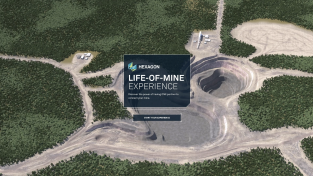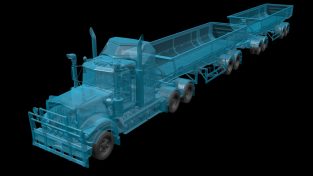Noise, distraction, busy traffic and poor visibility will always mean that mining is potentially dangerous but improvements to Hexagon’s collision avoidance system (CAS) continue to minimize those risks. The latest release of MineProtect CAS is the result of customer feedback, focused development and grueling field trials.
NJ: Noise, distraction, busy traffic and poor visibility will always mean that mining is potentially dangerous. However, improvements to Hexagon’s Collision Avoidance System, otherwise known as CAS, continue to minimise those risks. The latest release of MineProtect CAS is the result of customer feedback, focused development and grueling field trails. Thanks for tuning in, hi I’m Neville Judd from Hexagon Radio. Continuing with efforts to help mines in the pursuit of zero harm Hexagon has released an improved version of its market leading Collision Avoidance System, otherwise known as CAS. With us to discuss the new features is MineProtect Application engineer Florent Garin. Florent thanks for joining us today.
FG: Hi, Nev. Thanks for having me today on this Hexagon Radio podcast.
NJ: Pleasure to have you. So, Florent, describe some of the new features in CAS 4.6 and how they help customers.
FG: Alright. So, I would say with this latest 4.6 release we would have like three main features. The first one that we can talk about later is integration with IDS GeoRadar, which is basically an integration with a product from the GeoRadar division with the Collision Avoidance System. So, bringing one more layer of safety. The second feature would be what we call General Purpose Controller, known as GPC, which allows for behaviour customisations. And the last one is the UI Threat isolation. Either being isolating the threat among other traffic awareness LED’s.
NJ: So, let’s go back to the GPC, the General Purpose Controller. Tell us more about the features that have been added to that.
FG: Alright. We started it with the possibility of triggering customised behaviour just using collision alarms. Now though we have the possibility to use whatever alarms generated by CAS. Tailgating alarm, can be an over-speeding alarm, it can be a personal alert alarm, radar alarm, whatever alarm comes from CAS. What we can also do is create customised voice messages. Application example would be having a seat vibrator triggered and a voice announcement when you have a collision alarm, a haul truck versus a light vehicle high priority, meaning that the time to impact is less than three seconds. Then I would say application example are just going to kind of come with customers’ creativity based on their need.
NJ: I see. So, you talked earlier about the Threat Isolation feature. What are the benefits of that?
FG: So, what we want to achieve is make sure that we avoid collisions. That’s the basic principle of the system. How we enhance that is with this Threat Isolation. The Idea is to remove everything that is noncritical at this given moment. So, let’s say you are in a crowded place such as a face where a shovel is working, you have trucks around you, you may have other LVs, wheeldozer. So quite a large amount of mining units and if you are to collide with one of those, you want to see where it is, on which side it is. So, the Threat Isolation will just show you where this unit is. You will lose traffic awareness during the time of this alarm.
NJ: I see. So, I imagine the field trials for technology like this, potentially lifesaving technology, must be fairly grueling. Can you describe what the field trails were like for CAS 4.6 and explain what goes into proving the effectiveness of a solution like this?
FG: Alright. So, field trails as it says is in the field. We want to be as close as possible to a real operation. Obviously, we have to be very careful not to hinder production and release a tested version of the software in the nature. So, we first do some I would say small tests. So, driving around, kind of repeating scenarios to make sure that we a have the very core feature of the Collision Avoidance System. Then we take it in the pit to make sure that interactions are as expected and then we have a feature-based approach, that is to say that we run scenarios to make sure that our features are working as we expect them to work.
NJ: Ok. So, how do customers receive this release and what are the installation requirements for it?
FG: Ok. I would say we have here, let’s talk about first the customer and then the requirements. We have three groups of customers. The first one is the case of a brand new installation. So, those customers are going to receive the latest version. So, 4.6. Then if the customer has a maintenance contract then it’s going to be included in this contract. So, one just needs to get in touch with their Hexagon rep in the country and they will come onsite and perform the upgrade in a professional manner. And the last group is the customers who don’t have a maintenance contract. In this case, the process is basically the same but first they would have to ask for a quote. Requirements now, it’s important to note that this CAS 4.6 is only working with the latest CAS QC units. That is to say QC241, QC242 and QC250 revision B.
NJ: Ok. Finally, Florent, CAS 4.6 integrates with our GeoRadar solution for safety and radar-based slope stability hazards. Tell us about that.
FG: Right. This is the willingness of pushing integration of the different divisions or portfolios of Hexagon Mining and the basic idea behind the specific integration is to enhance the flow of information. So, from the geotechnical side it goes to the operations side very quickly. In one click a dangerous area mapped by the geotechnical team can be uploaded into the CAS units over either LTE or WIFI. For this I would encourage you to listen to Marcos Bayuelo and Francesco Coppi podcast in which you can learn more about this integration.
NJ: Florent, thanks again so much for joining us today.
Florent: My pleasure, Nev. I was happy to be here and hope it helps.
NJ: You bet. So, a big thank you to our guest, Florent. For more information about today’s topic visit hexagonmining.com where you’ll also find more details about CAS’s integration with IDS GeoRadar on our blogs page. To listen to additional episodes or learn more, visit hxgnspotlight.com. Thanks for tuning in.
















